
This research delves into blockchain interoperability, highlighting its significance in the evolving blockchain landscape. The study explores challenges in achieving seamless inter-blockchain communication and presents various use cases, from token exchanges to implications in Decentralized Finance (DeFi) and gaming. Different interoperability methods, such as Hashed Timelock Contracts (HTLCs) and sidechains, are discussed. The paper provides the analysis of leading interoperability platforms like Polkadot, Cosmos, and others, emphasizing their unique mechanisms and contributions. Major security breaches in the domain are also addressed, underscoring the need for robust security. In essence, the study offers a comprehensive yet concise overview of the current state and future prospects of blockchain interoperability.
Introduction
Blockchain technology, since its inception, has promised a decentralized future where transactions and data are immutable, transparent, and secure. As the ecosystem has evolved, numerous blockchains with varied architectures, protocols, and consensus mechanisms have emerged. While each blockchain offers unique features and advantages, they often operate in isolation, leading to fragmented data and limited interoperability. This isolation hinders the full potential of blockchain technology, as it limits collaboration, transparency, and the seamless exchange of value and information across different chains.
The concept of “Cross-chain interoperability” seeks to address this challenge by enabling different blockchains to communicate and interact seamlessly. Achieving this interoperability, however, is not without its challenges. From data fragmentation due to isolated blockchains to the diverse architectures and consensus mechanisms that make it difficult to design compatible solutions, the road to true interoperability is fraught with obstacles. Additionally, as the number of connected blockchains increases, scalability becomes a concern, potentially affecting performance and leading to network congestion. Security and privacy are also paramount, as cross-chain transactions introduce new complexities and potential vulnerabilities.
Despite these challenges, the importance of cross-chain interoperability cannot be understated. It has the potential to unlock new business models, revenue opportunities, and innovative applications by connecting different chains and leveraging their unique strengths. Projects like Cosmos, Chainlink, Polkadot and others are at the forefront of addressing interoperability issues, aiming to foster innovation, collaboration, and mass adoption.
In essence, this research delves deep into the realm of cross-chain interoperability, exploring its challenges, use cases, types, and the various solutions and approaches currently being developed in the blockchain space.
Understanding Interoperability
Blockchain interoperability refers to the ability of different blockchain networks to communicate, share data, and transact with each other seamlessly[2]. It enables blockchains to exchange information and digital assets without any centralized authority[5]. The foundation of blockchain interoperability is cross-chain messaging protocols, which allow blockchains to read data from and/or write data to other blockchains[1].
The significance of blockchain interoperability lies in its potential to unlock the full power of blockchain technology by breaking down the barriers of isolated networks[2]. Some of the key benefits of blockchain interoperability include:
- Greater efficiency. Interoperability allows for the smooth transfer of data and assets between different blockchain networks, reducing the need for manual processes and intermediaries, which increases overall efficiency[7].
- Increased scalability. By connecting different blockchains, it is possible to leverage the strengths of multiple networks, improving the scalability of the entire ecosystem[7].
- Enhanced innovation and creativity. Blockchain interoperability plays a significant part in the innovation and creativity that comes with new network designs[6].
- Mass adoption. Interoperability is foundational to the mass adoption of blockchain technology, as it reduces the barrier to entry for users who want to engage with protocols across multiple networks[4].
- Improved collaboration. Interoperability enables greater communication, the exchange of digital assets and data, and improved collaboration between different blockchain networks[3].
Challenges in Achieving Interoperability
Achieving blockchain interoperability comes with several challenges, some of them presented in the table:
Table 1 – Challenges of Blockchain Interoperability.
| Challenge | Description |
| Data fragmentation | Isolated blockchains operate independently, resulting in fragmented data and limited access to information, which hinders transparency and collaboration[2]. |
| Heterogeneous architectures | Blockchains have diverse architectures, protocols, and consensus mechanisms, making it difficult to design and implement compatible interoperability solutions[8]. |
| Scalability | Interoperability can face scalability issues as the number of connected blockchains increases, potentially affecting performance and network congestion[8]. |
| Security and privacy | Cross-chain transactions are more complex and difficult to secure than transactions within a single blockchain, and interoperability protocols can introduce new attack routes and vulnerabilities. |
| Lack of standardization | Different blockchain systems and languages make it challenging to establish a common standard for cross-chain communication, leading to interoperability issues[9]. |
| Limited skilled manpower | The field of blockchain interoperability is relatively new, and there may be a shortage of qualified professionals with experience in this area[11]. |
Despite these challenges, several projects are working on cross-chain solutions and standards to address interoperability issues, such as Cosmos, Chainlink, Polkadot, and Harmony. By overcoming these challenges, blockchain interoperability can unlock the full potential of blockchain technology, fostering innovation, collaboration, and mass adoption[10].
Blockchain Interoperability Use Cases
Blockchain interoperability has the potential to unlock new business models, revenue opportunities, and innovative applications by connecting different chains and leveraging their unique strengths[12]. As the blockchain ecosystem continues to grow and evolve, interoperability will play a crucial role in driving adoption, innovation, and collaboration across various networks.
Token exchange and transfer
Interoperability allows for the exchange of tokens between different blockchain networks, such as swapping Bitcoin for Ethereum or other cryptocurrencies. This can be achieved through techniques like atomic swaps, which enable the exchange of tokens between two or more participants without the need for a centralized intermediary[13].
Cross-chain state access and Smart contract function invocation
Interoperability enables access to states, transactions, or events across different blockchains, allowing for more elaborate use cases that require information from multiple networks. This can be achieved through notary schemes and chain relays.
Interoperability also allows for the execution of smart contract functions across different blockchains, enabling more complex and versatile applications[13].
DeFi
Liquidity transmission – enables the transmission of a given cryptocurrency’s liquidity from one blockchain to another, allowing users to access and utilize assets across different networks.
Cross-chain trading – allows users to trade assets on one chain for assets on another chain, facilitating seamless transactions and trades across different networks.
Cross-chain borrowing and lending – enables users to borrow assets on one chain by posting tokens or NFTs as collateral on another chain, allowing for more flexible and efficient financial services[14].
Gaming
Blockchain interoperability allows for interaction between different gaming ecosystems, enabling players to use their assets across multiple games and platforms. This can lead to innovation and collaboration between different gaming communities, as well as network effects that increase the adoption of blockchain technology in the gaming industry[15][16].
Types of Blockchain Interoperability
As the blockchain landscape expands, ensuring the different networks can communicate has become vital. This section explores the various methods to achieve this, from centralized intermediaries to advanced cryptographic protocols, highlighting the significance and challenges of cross-chain communication.
Centralized ways
Centralized ways of achieving blockchain interoperability involve the use of notary schemes, which rely on trusted third parties to manage transactions between different blockchains. These third parties, often referred to as notaries, can be a network of exchanges or a single controlled exchange. The integrity of the notary is the primary factor affecting the effectiveness of a notary scheme[17].
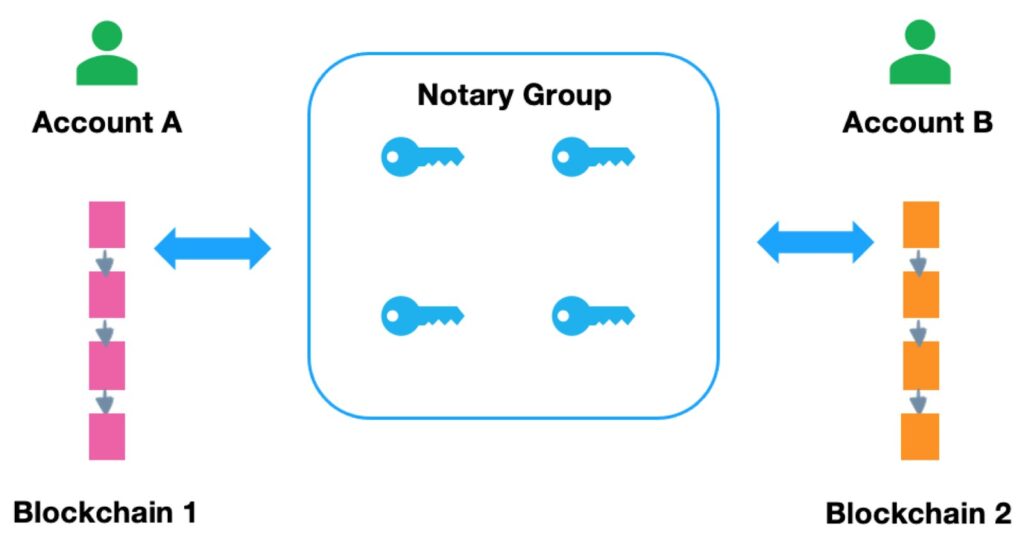
Figure 1 – Notary scheme[18].
Centralized cryptocurrency exchanges (CEX) like Coinbase and Binance are examples of notary schemes[17]. These exchanges act as intermediaries, allowing users to send assets from one blockchain to another, such as converting Bitcoin to Ethereum. Although these centralized solutions provide a simple way to achieve cross-chain interoperability, they come with some drawbacks. One of the main issues is that they rely on a centralized entity, which goes against the decentralized nature of blockchain technology. Additionally, these systems are vulnerable to failures or misbehavior of the centralized entity[19].
Another example of a centralized solution is Wrapped Bitcoin (WBTC), which involves BitGo Trust hosting assets in the Bitcoin blockchain and running a smart contract on Ethereum to issue WBTC and update its balance[20]. This approach is also centralized, as BitGo Trust acts as a custodian for the assets.
In summary, centralized ways of achieving blockchain interoperability, such as notary schemes and CEX, provide a simple and fast solution for cross-chain transactions. However, they come with drawbacks, including reliance on a centralized entity and potential vulnerabilities.
Hashed Timelock Contracts
Hashed Timelock Contracts (HTLCs) are a type of smart contract used in blockchain applications to enable conditional payments and minimize counterparty risks. They are particularly useful for blockchain interoperability, allowing for secure cross-ledger transactions without the need for a direct technical connection between the ledgers[21].
How HTLCs Work
An HTLC consists of two main components: a hashlock and a timelock. The hashlock is a cryptographic key generated by the payer, who hashes it and stores the hash until the final transaction is executed. The timelock is a locking mechanism that sets two deadlines for the transaction, ensuring that the receiver either acknowledges the payment within a certain period or forfeits the ability to claim it[22].
Here’s a step-by-step example of how an HTLC works in a cross-ledger transaction[21]:
- Alice wants to trade an asset on Ledger A with Bob’s asset on Ledger B.
- Alice creates a secret key and a hash of that secret key.
- Alice locks her assets on Ledger A in an HTLC using the hash. The assets will be transferred to Bob once the secret corresponding to the hash is presented.
- Alice shares the hash with Bob.
- Bob locks his assets on Ledger B using the same hash. The assets will be transferred to Alice once the secret corresponding to the hash is presented.
- Alice reveals the secret key to claim Bob’s assets on Ledger B.
- Bob uses the revealed secret key to claim Alice’s assets on Ledger A.
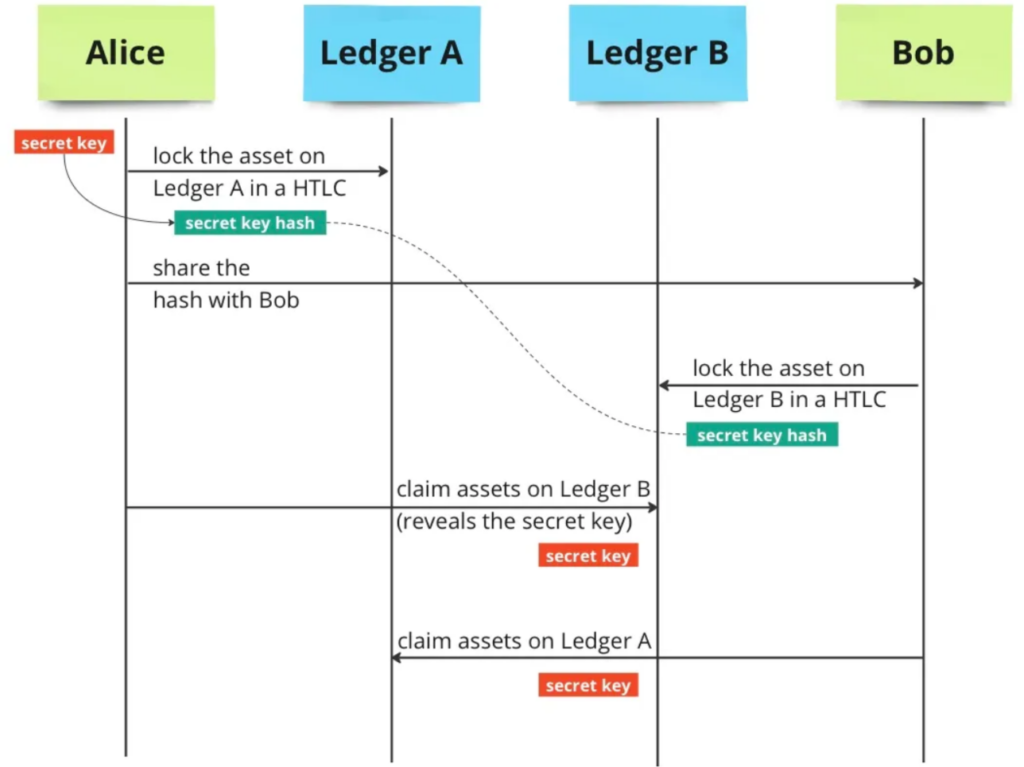
Figure 2 – HTLC flow[21].
This process ensures that the assets are securely exchanged between Alice and Bob without the need for a trusted third party or a direct connection between the two ledgers.
Examples of HTLCs in Blockchain Interoperability
HTLCs are widely used in blockchain interoperability solutions, such as the Lightning Network for Bitcoin. The Lightning Network uses HTLCs to enable off-chain, scalable, and instant payments by creating payment channels between users. These payment channels can be routed across multiple channels, allowing for seamless transactions between different parties without the need for on-chain transactions[22].
Another example of HTLCs in blockchain interoperability is atomic swaps, which enable the cross-exchange of assets on different blockchain platforms without the need for trusted third parties or notaries. In atomic swaps, users lock their assets in an HTLC, and the assets remain locked until the swap is completed or the HTLC expires. This technique allows users to hold ownership of their assets on different blockchains, giving them the freedom to choose where they want to keep their assets[23].
Two-way pegging
Two-way pegging is a mechanism that enables the transfer of assets between a main blockchain (Layer 1) and a sidechain, and vice versa while maintaining a consistent value between the two chains. It is a fundamental aspect of sidechains that establishes a secure connection between the main and sidechains, allowing users to transfer their assets seamlessly between the two chains in a verifiable and trustless manner[24].
In a two-way peg, assets are not actually transferred between the chains. Instead, they are locked on the mainchain while an equivalent amount of assets is unlocked on the sidechain. This process typically involves a series of cryptographic proofs and smart contracts[24].
Two-way pegs are essential for facilitating cross-chain communication and asset transfers, as they enable seamless interaction between different blockchain networks. They can be implemented using various types of bridges, such as Powpegs, SPV, hybrid-SPV, federated, and collateralized bridges, each with their own pros and cons[25].
Sidechains
A sidechain is a separate blockchain network that connects to another blockchain, called a parent blockchain or mainnet, via a two-way peg. Sidechains have their own consensus mechanisms, governance rules, and block parameters. They are responsible for their own security and require their own nodes to validate transactions and create blocks. Examples of sidechains include Bitcoin’s Liquid Network and RootStock (RSK), as well as Ethereum’s xDai Chain, POA network, and Polygon (formerly known as Matic network)[26][27].
Sidechains work by allowing transactions to be moved from the main blockchain to a parallel network, similar to moving traffic from a congested highway to a parallel road. This helps to improve scalability and allows developers to test new ideas, features, and consensus mechanisms without affecting the stability or security of the mainchain[28].
Cross-chain Messaging Protocols
Cross-Chain Messaging Protocols are a type of blockchain interoperability solution that enables communication between different blockchain networks. There are many kinds of custom cross-chain messaging protocols that facilitate the transfer of data, tokens, and other assets between blockchains, allowing decentralized applications (DApps) to access data and interact with smart contracts on different chains[29].
One example of a Cross-Chain Messaging Protocol is the Cross-Chain Interoperability Protocol (CCIP) developed by Chainlink. CCIP provides a single, elegant interface for all cross-chain use cases, allowing developers to securely send messages, transfer tokens, and initiate actions across blockchains. It is powered by Chainlink’s industry-standard oracle networks and features additional layers of protection via the Risk Management Network and transfer rate limits[30].
Another example is the ZK Cross-chain Message Protocol[31]. This protocol leverages zero-knowledge (ZK) technology to enable secure and cheap cross-chain communication. It allows DApps to communicate with each other on different chains and access states of different chains. The development of cross-chain DApps using ZK technology is expected to have a significant impact on the DeFi and development sectors in the coming years.
Interoperable Blockchain Platforms
Interoperable blockchain platforms enable different blockchain networks to communicate and work with each other, allowing for seamless data and asset exchange between various blockchain platforms without the need for a central authority or intermediary. This is achieved through cross-chain messaging protocols, which enable blockchains to read data from and/or write data to other blockchains[1].
Examples of Interoperable Blockchain Platforms
Polkadot – Polkadot is designed to enable interoperability between blockchains, building an entire ecosystem of blockchains that can easily communicate with each other. Polkadot serves as the central relay chain, connecting multiple parachains that can interact with each other[32].
Cosmos – Cosmos is another interoperable blockchain platform that aims to create an “Internet of Blockchains” by connecting multiple independent blockchains. It uses a hub-and-spoke model, where the Cosmos Hub connects to various blockchains called zones, allowing them to exchange data and assets[33].
Conclusion
Blockchain interoperability stands as a cornerstone in the maturing landscape of the blockchain ecosystem, bridging the gaps between disparate networks and enabling fluid communication. Centralized methods, such as notary schemes and centralized cryptocurrency exchanges, offer a direct route to cross-chain transactions. However, their inherent reliance on a central entity contradicts the decentralized spirit of blockchain, introducing potential vulnerabilities.
On the decentralized front, Hashed Timelock Contracts (HTLCs) have emerged as a robust solution. They ensure secure, conditional payments across ledgers without the need for direct connections. Foundational to innovations like the Lightning Network and atomic swaps, HTLCs represent the future of secure cross-ledger transactions. Parallel to this, two-way pegging mechanisms, essential to sidechains, maintain a consistent asset value between main blockchains and sidechains. This ensures seamless cross-chain communication and asset transfers, with a variety of bridge implementations to choose from.
Sidechains themselves, operating as auxiliary blockchains, offer a solution to scalability issues and provide a testing ground for new blockchain features without risking the stability of the mainchain. Further enhancing the interoperability landscape are Cross-chain Messaging Protocols. Protocols such as Chainlink’s CCIP and the ZK Cross-chain Message Protocol empower decentralized applications to function across different blockchains, heralding a new wave of cross-chain development.
Lastly, platforms like Polkadot and Cosmos are pioneering the realm of blockchain interoperability. These platforms envision a future where multiple blockchains coexist and interact seamlessly. As the blockchain domain continues its evolution, these interoperability mechanisms will play an increasingly pivotal role, guiding us towards a more integrated and collaborative blockchain era.
Current Solutions and Approaches
The blockchain landscape has witnessed a surge in innovations aimed at enhancing communication and interaction between disparate chains. As the decentralized ecosystem grows, the need for seamless and efficient cross-chain interoperability becomes paramount. While numerous protocols and solutions claim to bridge this gap, not all are created equal. The reliability, security, and efficiency of these solutions vary, highlighting the importance of discerning the most promising from the rest.
This section provides an overview of the most reputable approaches to blockchain interoperability, evaluated based on their Twitter score and market cap. The aim is to offer a comprehensive perspective on the current state of cross-chain solutions. From the decentralized liquidity protocol of Thorchain to the interconnected and scalable nature of Cosmos, the nuances that set each solution apart are explored. This exploration navigates the intricate web of cross-chain interoperability, shedding light on the protocols that are shaping the future of blockchain communication.
Polkadot
Polkadot is a scalable heterogeneous multi-chain blockchain platform designed to enable communication among different blockchains. It was first introduced in 2016 when Gavin Wood, co-founder of Ethereum, published a white paper outlining the technical vision and rationale behind the project. The platform was officially launched in May 2020[34].
Polkadot consists of a collaborative decentralized blockchain network called the relay chain that interacts with sharded chains running in parallel, known as parachains. These parachains can be considered as clients of the relay chain, whose purpose is to secure and coordinate them. The platform aims to break down the barriers between various blockchain ecosystems, allowing intermediary-free communication among these networks[35].
The native cryptocurrency for the Polkadot blockchain is the DOT token. DOT serves two main functions within the Polkadot network: it is a governance token, which allows holders to have a say in the future of the protocol, and it is used for staking, which is the way the Polkadot network verifies transactions and issues new DOT tokens[36].
Polkadot’s architecture enables it to process transactions in parallel, which increases its transaction speed compared to other blockchains. The platform also contains bridges that connect blockchains and allow data transfer.
Polkadot has a sophisticated system of governance, which involves all DOT token holders in decision-making processes. The platform is developed by Parity Technologies and run by the Web3 Foundation (W3F), both co-founded by Gavin Wood[34].
How Polkadot Achieves Interoperability
Polkadot achieves interoperability through its unique architecture, which consists of XCM, relay chains, parachains, and bridges.
Relay Chains
The relay chain is the central chain of Polkadot, responsible for securing and coordinating the connected parachains. All validators of Polkadot are staked on the relay chain, and it shares its security with the connected parachains. The relay chain’s primary purpose is to facilitate communication and provide shared security among different blockchains[37].
Parachains
Parachains are parallel blockchains connected to the Polkadot relay chain. They enable decentralized applications to scale beyond the limitations of a single blockchain by accessing the resources of the Polkadot network. Parachains can be customized for specific use cases while still being interoperable with other parachains and blockchains in the Polkadot ecosystem. Interoperability is enabled by the connection between Polkadot parachains and the relay chain[38].
Bridges
Bridges are used to connect the Polkadot ecosystem to external blockchains like Bitcoin, Ethereum, and Tezos, among others. They serve as a link for the exchange or movement of tokens between chains. Polkadot prefers trustless bridges, which are more decentralized and secure. Several bridges have already been developed or are currently being developed to connect Polkadot with external networks, such as Wanchain, which links Polkadot to the wider cross-chain DeFi community[39].
Cross-Consensus Message Format (XCM)
The Cross-Consensus Message Format (XCM) is a messaging format and language used to communicate between consensus systems, such as blockchains, smart contracts, and other decentralized systems. XCM is designed to be a generalized and extensible set of instructions for completing transactions across different consensus systems[40].
XCM is not specific to Polkadot, as it aims to be a generic and extensible language between different consensus systems. In the Polkadot ecosystem, XCM is used for cross-chain communication, enabling cross-blockchain transfers of any type of data or asset. Polkadot implements two cross-consensus or transport protocols for acting on XCM messages between its constituent parachains[41]:
- Vertical Message Passing (VMP): Divided into two kinds of message-passing transport protocols[41]:
- Upward Message Passing (UMP): Allows parachains to send messages to their relay chain.
- Downward Message Passing (DMP): Allows the relay chain to pass messages down to a parachain.
- Cross-Consensus Message Passing (XCMP): Enables parachains to exchange messages with other parachains that are connected to the same relay chain. XCMP can be thought of as a horizontal—parachain-to-parachain—transport protocol[40].
XCM aims to abstract the typical message intentions across these systems and provide a basic framework for forward-compatible, extensible, and practical communication datagrams facilitating typical interactions between disparate data systems within the world of global consensus[42].
Cosmos
Cosmos is a decentralized network of independent, scalable, and interoperable blockchains, which aims to address issues related to scalability, usability, and interoperability in the blockchain space. The Cosmos ecosystem was officially introduced in 2016 with the publishing of the Cosmos whitepaper and the launch of the Interchain Foundation. The ecosystem includes all the blockchains built using the Cosmos Software Development Kit (SDK). Some notable projects within the Cosmos ecosystem are Binance Chain, Crypto.org, and other recently-launched protocols[43].
At the core of the Cosmos ecosystem is the Cosmos Network, which is governed by the ATOM token. The Cosmos SDK is a developer-friendly, modular framework that facilitates the easier deployment of blockchains, such as BNB Smart Chain, Terra, and Kava. The native cryptocurrency of the Cosmos ecosystem is the ATOM token, which is used in the proof-of-stake consensus mechanism to maintain the network and reward ATOM holders[44].
Cosmos offers a suite of tools to build interoperable application-specific chains, including the Cosmos SDK, Tendermint, the Inter-Blockchain Communication protocol (IBC), and the Cosmos Hub. The Cosmos Hub is one of the blockchains connected to the ecosystem, built by the Cosmos team, and keeps a record of the total number of tokens in each zone. The Cosmos Network, also called Cosmos, designates the whole ecosystem[45].
The Cosmos Hub and Zones
In the Cosmos ecosystem, there are two main classes of blockchains: Hubs and Zones. Hubs serve as routers for Zones and can also be connected to other Hubs. Zones, on the other hand, are connected to a Hub and only need to establish a single connection with a Hub to be interoperable with all other Zones. Anyone can create a Hub or a Zone on the Cosmos ecosystem, and blockchains are free to accept or refuse connections between each other[43].
The Cosmos Hub is the first blockchain launched on the Cosmos network and serves as the primary blockchain connecting Cosmos’ customized blockchains, known as Zones. It keeps a record of each Zone’s state and is the economic center, providing vital services to the Interchain. The core mission of the Cosmos Hub is to connect chains by establishing IBC (Inter-Blockchain Communication) connections and operating decentralized bridges with chains like Ethereum and Bitcoin. The Cosmos Hub maintains security, specifically token balances between Zones, ensuring that even if one Zone fails catastrophically, it wouldn’t affect the overall supply of tokens in the Cosmos network or the accounts[46].
Each Zone in the Cosmos ecosystem can function autonomously, from authenticating accounts and transactions to creating and distributing new tokens and executing blockchain changes. Zones connect to other Zones through Hubs, with the Cosmos Hub being the main one, although other Hubs are also available. Each new Zone is linked to the Cosmos Hub, which keeps a record of each Zone’s state and vice versa[47].
The Inter-Blockchain Communication (IBC) Protocol
The Inter-Blockchain Communication (IBC) protocol is a communication standard that enables different blockchains to relay messages to each other, allowing for secure and decentralized interoperability between heterogeneous chains[48]. IBC was designed and developed as a core component of the Cosmos network, and it is used by Cosmos blockchains to connect and communicate with other blockchains via it[49]. There are over 100 IBC-enabled chains as of today.
IBC consists of two distinct layers: the lower transport, authentication, and ordering layer (IBC/TAO) and the upper application layer[49]. The IBC/TAO layer is responsible for transporting, authenticating, and ordering data packets between blockchains, while the application layer defines the semantics of the data packets and how they should be interpreted.
One of the key benefits of the IBC protocol is its ability to enable interoperability between different blockchain networks, allowing previously siloed networks to exchange value and data in a secure and decentralized manner. This interoperability facilitates the creation of more complex and robust decentralized applications (dApps) and allows developers to build cross-chain applications, including cross-chain smart contracts, messaging, NFT transfers, oracle data feeds, and more[48].
IBC connections are established by relayers between light clients on each chain, which facilitates the packet relays using channels. Connections are securely established using a handshake protocol, and the state of the connection is tracked on each chain[50].
CosmWasm: Smart Contracts on Cosmos
CosmWasm is a pioneering smart contracting platform tailored for the Cosmos ecosystem. It empowers developers to craft secure smart contracts using Rust, which are then compiled into WebAssembly (Wasm) binaries[53]. As a modular framework, it seamlessly integrates with the Cosmos SDK, offering a streamlined approach for blockchain developers to incorporate smart contract capabilities[51][52].
IBC Transactions
CosmWasm boasts a robust integration with the Inter-Blockchain Communication (IBC) protocol. This union facilitates the creation of smart contracts that support cross-chain asset transfers, enabling users to effortlessly send and receive tokens across diverse blockchain networks. The intrinsic relationship between CosmWasm and IBC paves the way for a multi-chain future, devoid of reliance on trusted intermediaries[51]. Together, they form a highly interoperable infrastructure, fostering seamless communication and data exchange between disparate blockchain networks[54].
Main Advantages
Flexibility: CosmWasm’s modular nature allows for easy integration with the Cosmos SDK, enabling blockchain developers to add smart contract functionalities without overhauling existing logic[53][52].
Security: CosmWasm’s design emphasizes security. The source code undergoes rigorous verification by the compiler, and the resulting binary is self-contained, with all dependencies statically linked. This design choice thwarts potential attackers from altering any segment of the contract post-deployment.
Interoperability: With native IBC integration, CosmWasm stands at the forefront of blockchain interoperability, allowing for native multi-chain smart contract applications[51][52].
Cost-Efficiency: CosmWasm offers a more resource-efficient environment, translating to better cost-efficiency compared to other platforms[55].
Decentralization: The platform supports cross-chain transactions without the need for trusted third parties, ensuring a decentralized and trustless ecosystem[51][52].
Efficiency: In comparison to the traditional Ethereum virtual machine, CosmWasm stands out as a more resource-efficient smart contract environment[55].
Cross-Chain Interoperability Protocol
Chainlink’s Cross-Chain Interoperability Protocol (CCIP) is a groundbreaking technology that aims to establish a universal connection between hundreds of blockchain networks, both private and public, unlocking isolated tokens and data. It provides smart contract developers with a generalized, compute-enabled infrastructure for transferring data and smart contract commands across blockchain networks. CCIP is the result of years of research and development in secure cross-chain technology, dating back to the original intentions of the Chainlink 1.0 Whitepaper[56].
Significance of CCIP
- Interoperability. It enables DeFi applications to access users and interface with other DeFi applications across different blockchains, all from a single interface. This allows for seamless connections between existing financial systems and public and private blockchains, making it easy for them to transition existing assets and financial services on-chain[57].
- Security. CCIP raises the bar in cross-chain security by introducing new features, such as rate limits on token transfers to minimize potential damage, and the Risk Management Network—an independent network that verifies cross-chain operations for erroneous activity[57].
- Foundation for an interoperable blockchain ecosystem. Similar to TCP/IP’s foundational role in Internet communication, Chainlink CCIP serves as the foundation for an interoperable blockchain ecosystem[57].
- Cross-chain smart contract stack. CCIP creates a cross-chain smart contract stack, enabling the development of hybrid inter-blockchain smart contracts[58].
- Programmable Token Bridge. CCIP underpins various cross-chain services, such as the Chainlink Programmable Token Bridge, which allows users to move their tokens across any blockchain network in a highly secure, scalable, and cost-efficient manner[56].
- Universal messaging interface. With a universal messaging interface, smart contracts can communicate across multiple blockchain networks, eliminating the need for developers to write custom code for building chain-specific integrations.
How CCIP facilitates cross-chain communication
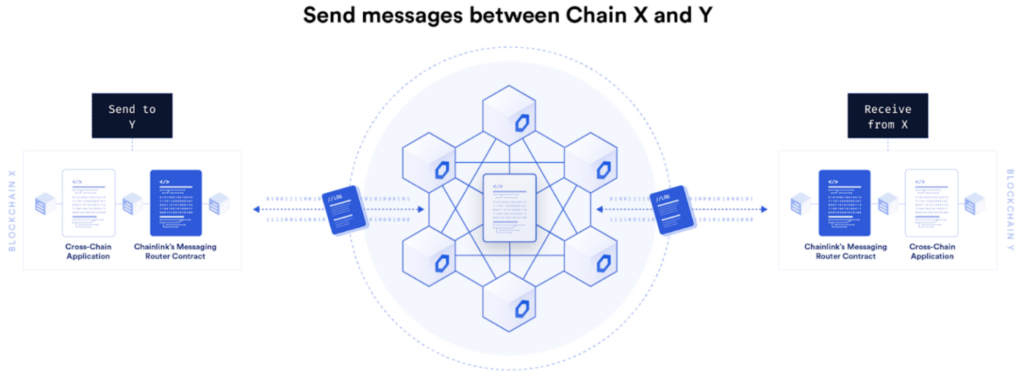
Figure 3 – CCIP sending messages[56].
Chainlink’s Cross-Chain Interoperability Protocol (CCIP) facilitates cross-chain communication by providing a universal messaging interface for smart contracts to communicate across multiple blockchain networks. This eliminates the need for developers to write custom code for building chain-specific integrations and enables efficient and secure communication between blockchains[30].
CCIP allows the transfer of data packets between smart contracts on different blockchain networks. It acts as an intermediary for the transfer of data and tokens between the involved blockchains, ensuring that data is transmitted reliably between them. This communication goes beyond just the exchange of assets; it enables blockchains to utilize each other’s facilities, including security infrastructure, scalability infrastructure, and transaction processing facilities[59].
Some specific use cases for CCIP in cross-chain applications include DeFi, cross-chain ENS, minting NFTs on multiple chains, and cross-chain gaming. By providing a layer of abstraction for developers, CCIP aims to become the standard protocol for cross-chain interoperability, making it easier to build cross-chain applications without the need to understand the underlying protocols[59].
LayerZero
LayerZero is a trustless omnichain interoperability protocol that enables direct communication between both Layer 1 and Layer 2 blockchain networks[61]. It acts as a universal translator for different blockchains, facilitating the exchange of assets and the utilization of various applications across multiple chains[60].
The architecture and design principles
LayerZero’s design is modular and extensible, allowing for the addition of new chains and functionalities without requiring modifications to the core protocol. This modular design enables seamless integration of new chains into the LayerZero network whenever needed. Moreover, when two chains need to communicate, it only requires that their respective libraries be present on both ends. This feature allows LayerZero to function as a fully connected network, facilitating transactions between any two chains within the network[60].
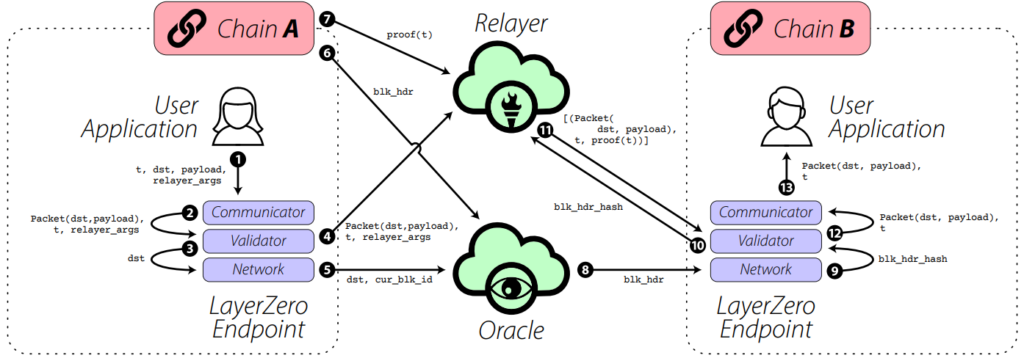
Figure 4 – The communication flow in a single LayerZero cross-chain transaction[61].
LayerZero Endpoint
The architecture of LayerZero is centered around the LayerZero Endpoint, which is implemented as a set of smart contracts on each chain within the LayerZero network[60]. The core functionality of the LayerZero Endpoint is divided into four modules:
- Communicator: Responsible for sending and receiving messages between different blockchain networks.
- Validator: Ensures the validity of transactions and messages.
- Network: Manages the connections between different blockchain networks.
- Libraries: Contains the necessary code for each blockchain network to interact with LayerZero[61].
These modules operate in a similar manner to a network stack, with messages flowing down the stack from the Communicator to the Validator and then to the Network on the sender side. On the recipient side, messages travel up the stack in reverse order[60].
Oracle
The Oracle is responsible for moving data from one chain to another and securing the network. It helps verify the validity and finality of cross-chain messages. LayerZero allows decentralized app developers to choose their preferred Oracle, making the system more modular and secure. Google Cloud has recently partnered with LayerZero to become the default oracle provider, further enhancing the infrastructure and security of the protocol[62][63].
Relayer
The Relayer is responsible for delivering messages between different blockchain networks. By default, User Applications use the LayerZero Relayer, which is run and maintained by LayerZero Labs as a production asset for the ecosystem. Relayers work in tandem with Oracles to ensure the seamless transfer of messages and transactions across chains. They are incentivized to be transparent and are rewarded for completing transactions[63].
How LayerZero achieves interoperability
LayerZero achieves interoperability through a unique approach called “Ultra Light Nodes” (ULNs), which are lightweight blockchain clients that can implement standardized data formats, common consensus mechanisms, secure communication channels, and interoperability protocols that are secure and scalable[63]. The LayerZero protocol enables interoperability across multiple blockchains regardless of their architecture.
LayerZero operates as a User Application (UA) configurable on-chain endpoint that runs an Ultra Light Node (ULN). It relies on two parties to transfer messages between on-chain endpoints: the Oracle and the Relayer[63]. The Oracle forwards the block header to the endpoint on the destination chain, and the Relayer submits the message. This process ensures that the transaction on the recipient’s chain matches a valid, committed transaction on the sender’s chain.
Valid delivery is a core concept in LayerZero, which guarantees that every message sent over the network is coupled with a transaction on the sender-side chain. A message is delivered to the receiver if and only if the associated transaction is valid and has been committed on the sender-side chain[64]. This concept is fundamental to LayerZero’s interoperability.
Quant
Quant is a DLT service provider that emphasizes enhancing the interoperability of blockchains. Founded by Gilbert Verdian, the company was inspired by the potential of DLT to address challenges faced in the public sectors of the UK and Australia. Quant’s flagship product, the Overledger DLT Gateway, facilitates communication across multiple blockchains like Bitcoin, Ethereum, and more. This platform’s unique capability allows for the development of mDApps that function across various blockchains. With support for diverse programming languages and the flexibility to introduce new tokens and adapt smart contracts, Quant stands out as a significant player in the blockchain domain[65].
How Quant facilitates cross-chain communication
Quant facilitates cross-chain communication through its Overledger technology, which is designed to connect and enable seamless communication between multiple blockchains. Overledger is not a blockchain itself but rather a distributed ledger technology (DLT) gateway that supports various DLTs, allowing developers to create multi-DLT applications (mDApps)[65].
The Overledger protocol architecture consists of four layers that work together to ensure seamless communication between multiple blockchains. These layers include the Transaction Layer, the Filtering and Ordering Layer, the Messaging Layer, and the Application Layer. Applications can interact with each other through the Messaging Layer, with messages passing from the Filtering and Ordering Layer to the Application Layer if they meet the filtering requirements[66].
By enabling cross-chain communication, Quant allows developers to create mDApps that can operate on multiple blockchains simultaneously, taking advantage of each blockchain’s unique features without being restricted by their limitations[67]. This interoperability solution helps bridge the gap between different blockchain networks and contributes to a more connected and efficient decentralized ecosystem.
ZetaChain
ZetaChain is a foundational, public blockchain that enables omnichain interoperability, generic smart contracts, and messaging between any blockchain. Launched in 2021, it aims to solve the problems of cross-chain and multi-chain communication and open the crypto and global financial ecosystem to everyone[68].
The platform enables omnichain decentralized applications (odApps), which can facilitate liquidity on multiple networks while also updating the states of connected networks. ZetaChain provides two ways for users and developers to utilize its cross-chain capabilities: EVM-compatible smart contracts and native smart contracts that can read and write to connected chains. This allows developers to build odApps with the same ease as developing dApps for a single network like Ethereum or Polygon while leveraging composability across networks[70][69].
Technology and Protocols behind ZetaChain
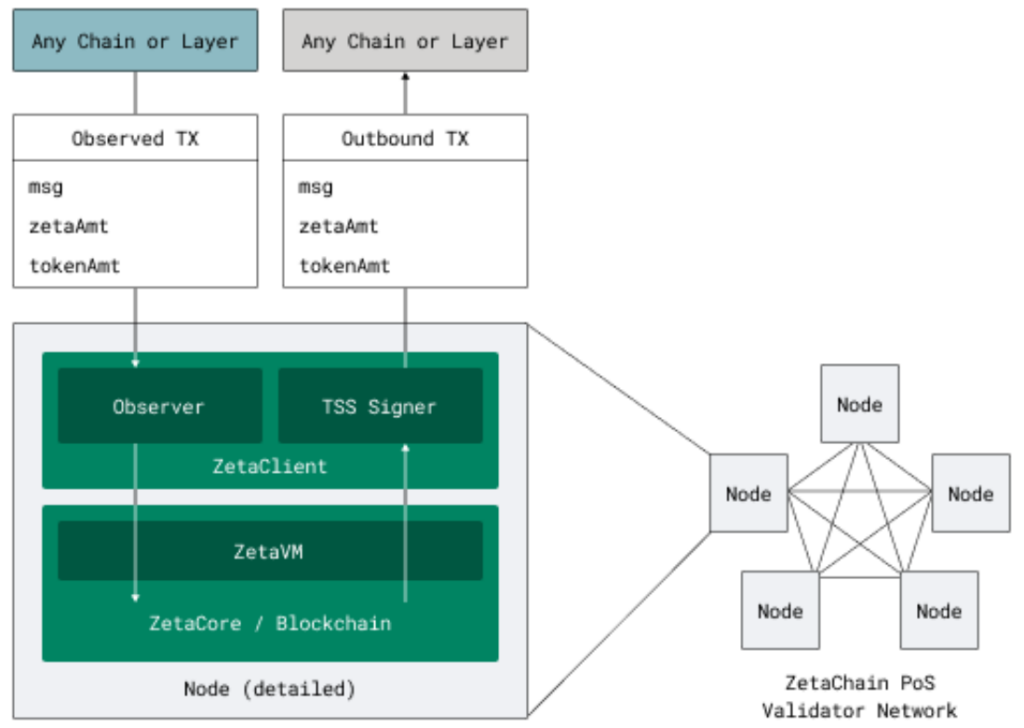
Figure 5 – ZetaChain High-Level Architecture[70].
ZetaChain is built on the Cosmos SDK and Tendermint Consensus, which provides a decentralized and public blockchain network[68]. It uses a Proof-of-Stake (PoS) consensus mechanism to ensure security, longevity, and scalability. ZetaChain’s core protocol is written in Go using Cosmos SDK and Comet BFT.
The platform connects both smart contract blockchains, such as Ethereum, Ethereum L2 rollups, Solana, Terra, and Algorand, and non-smart contract blockchains like Bitcoin and Dogecoin. It achieves this through observers and signers for external blockchains. Observers scan external chains for relevant events, transactions, and states at a point in time, and reach consensus on observation on ZetaChain’s blockchain. Signers collectively possess a single Threshold Signature Scheme (TSS) key that can send authenticated messages to external chains and hold assets like normal accounts[70].
ZetaChain’s smart contracts are written in Solidity, and the platform provides scripts to compile the contracts and generate Go bindings. Developers can create omnichain decentralized applications (odApps) as easily as developing dApps for a single network like Ethereum or Polygon while leveraging aggregation across networks[72].
Cross-chain messaging (CCM) is another feature that ZetaChain offers, allowing users to send messages from any connected chain to any connected chain, including ZetaChain itself. This makes it possible for applications that need minimal logic or state to maintain across all chains and where data needs only to be passed between different chains one way[71].
Thorchain
Thorchain is a decentralized cross-chain liquidity protocol that enables native asset swaps between different blockchain networks without relying on wrapped or pegged tokens. The mechanism of cross-chain swaps in Thorchain is facilitated by validators running full nodes for every supported network, such as Bitcoin, Ethereum, Binance Smart Chain, Avalanche, and Litecoin. These validators maintain Thorchain vaults containing pools of both the network’s native currency (e.g., ETH, BTC, LTC) and RUNE, Thorchain’s own token[72].
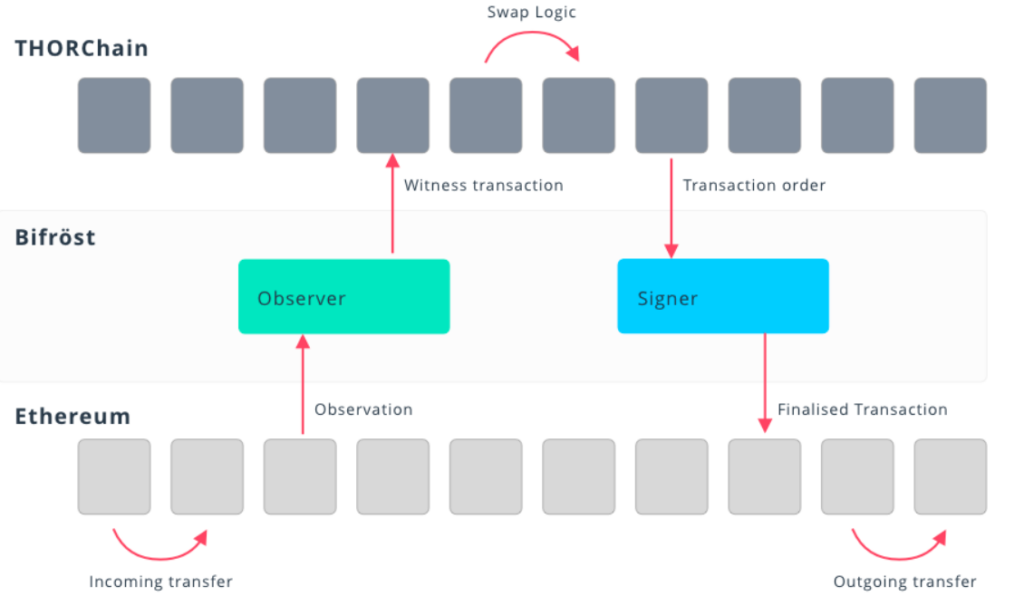 Figure 6 – How THORChain works[75].
Figure 6 – How THORChain works[75].
THORChain Protocols and Architecture
THORChain is built on the Cosmos SDK and Tendermint consensus engine. It uses a network of nodes, called THORNodes, to facilitate cross-chain swaps between different blockchain networks without relying on wrapped or pegged tokens. The protocol manages funds directly in on-chain vaults and secures them using economic security[72].
THORChain uses a unique consensus mechanism called Proof of Bond, which is similar to Proof of Stake. Validators, or THORNodes, are required to bond their native token, RUNE, to participate in the rotating consensus process. The network uses Tendermint and Threshold Signature Schemes (TSS) to provide a layered Byzantine Fault Tolerance (BFT) consensus mechanism, with a two-thirds majority consensus required for funds to enter and exit the primary TSS vault[74].
The Bifröst Protocol is the core of THORChain’s cross-chain compatibility, using a set of bridges that are unlike the traditional bridge. It handles observations of incoming transactions, which are passed into THORChain via special witness transactions. The Bifröst also handles multi-party computation to sign outgoing transactions via a Genarro-Goldfeder TSS scheme[73].
Flare
Flare is an Ethereum Virtual Machine (EVM)-based Layer 1 blockchain that focuses on providing developers with secure, decentralized access to high-integrity data from other chains and the internet. It was designed to enable open, decentralized, and safe interoperability between blockchains and also between blockchains and web2 APIs. Flare’s main objective is to scale the use of blockchain technology by allowing all digital assets and on-chain information to flow freely[76].
Flare’s interoperability capabilities have been demonstrated in various use cases, such as purchasing a non-fungible token (NFT) on its EVM network using tokens from two different blockchains, XRP and Dogecoin (DOGE)[77].
Technology and Protocols behind Flare
Flare is a Layer 1 blockchain secured by Avalanche consensus mechanism that leverages the EVM to support smart contracts and host decentralized applications (dApps). It prioritizes blockchain interoperability, enabling communication between different blockchains. Flare has two core native data acquisition protocols: the Flare Time Series Oracle (FTSO) and the State Connector[76][78].
Flare Time Series Oracle (FTSO)
The FTSO serves as a source of reliable off-chain data to be used on the network[78]. It delivers highly-decentralized price and data feeds to dApps on Flare without relying on centralized providers. Each data provider’s submission is weighted by its stake and any stake delegated to it by holders of Flare. This ensures decentralized price feeds that are rapidly updating, extendable, accurate, and incentivize participation.
State Connector
The State Connector drives the network’s ability to offer blockchain interoperability[78]. It enables information from other blockchains and the internet to be used securely, scalably, and trustlessly with EVM-based smart contracts on Flare chains. This allows Flare to bring the functionality of smart contracts to various crypto assets, such as Dogecoin, XRP, Litecoin, and Stellar, enabling these coins to be used in DeFi protocols, the NFT sphere, and other use cases[79].
Flare’s Native Token (FLR)
Flare’s native token, FLR, has multiple uses on the network, including incentivizing adoption and decentralization of the FTSO, securing the network, and participating in the network’s governance[78].
Wormhole
Wormhole is a decentralized, universal message-passing protocol that connects multiple blockchains and enables developers to build decentralized applications (DApps) that span across different blockchain networks[80]. It was designed to address two major issues in the blockchain ecosystem: token transferability and interchain interoperability.
Wormhole is the kind of notary scheme where notaries are 19 guardians (validator nodes) forming decentralized message validation. The main use case is the bridge where users can transfer tokens, NFTs, and other digital assets between various blockchains, such as Ethereum, Solana, Terra, Binance Smart Chain, Polygon, Avalanche, Oasis, and Fantom[80]. This is achieved through a token bridge, where guardians (validator nodes) verify and lock the native tokens in a smart contract on the source chain, and an equivalent number of tokens are minted as wrapped assets on the target chain[81].
The Wormhole protocol offers several advantages over traditional token bridges. It supports a wide range of popular blockchains, enabling developers to build cross-chain applications with ease[81]. Additionally, Wormhole provides a low-code solution for multiple cross-chain use cases, making it simpler for tokens, NFTs, apps, and other messaging applications to work together across different chains.
The architecture of Wormhole
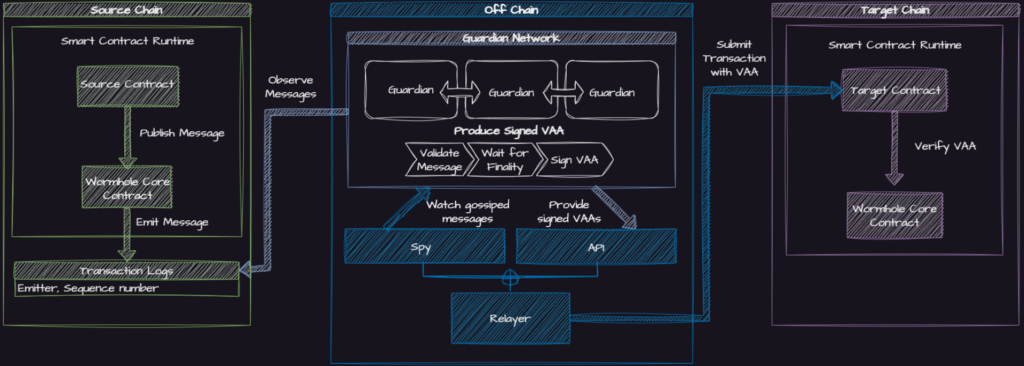
Figure 7 – Message passing flow[82].
The architecture of Wormhole consists of several key components that work together to facilitate cross-chain communication and asset transfers.
Table 2 – The architecture components of Wormhole.
| Component | Description |
| Core Contracts | These contracts are present on each blockchain in the ecosystem and are responsible for emitting messages that Guardians observe. They enable cross-chain communication and are the primary mechanism through which Wormhole messages are emitted[82]. |
| Guardians | Guardians are distributed nodes that monitor the state of multiple blockchains. They observe messages and sign the corresponding payloads, forming a multisig that represents proof of the observed state agreed upon by a majority of the Wormhole network. These multisigs are referred to as Verifiable Action Approvals (VAAs)[82]. |
| Verifiable Action Approvals (VAAs) | VAAs are the core messaging primitive in Wormhole, acting as packets of cross-chain data emitted when a cross-chain application contract interacts with the Core Contract. They consist of a Header and a Body, and once a majority of Guardians observe the message and achieve finality, the Guardians sign a keccak256 hash of the message body[82]. |
| Relayers | Relayers are processes that deliver VAAs to their destination, playing a crucial role in Wormhole’s security model. They act as delivery mechanisms for VAAs without the capacity to tamper with the outcome. There are three primary types of relayers: client-side relaying, specialized relayers, and generic relayers[82]. |
| Emitter | An Emitter is a contract that calls the publish message method on the Core Contract. The Core Contract writes an event to the Transaction Logs with details about the emitter and sequence number to identify the message[82]. |
| xAsset Contracts | These contracts allow normal tokens to be converted to xAssets and enable these xAssets to be bridged across different blockchains[83]. |
| Worm Router Contracts | These contracts allow developers to make their DApp a cross-chain application that users on any Wormhole-supported chain can interact with purely through client-side interactions[82]. |
Comparative summary
In the realm of blockchain interoperability, Polkadot, Cosmos, and Cross-Chain Interoperability Protocol emerge as frontrunners, pioneering the main protocols that facilitate seamless communication between diverse blockchain networks.
Polkadot stands out with its heterogeneous multi-chain platform, designed to foster communication among different blockchains. Its relay chain, in collaboration with parachains, aims to dissolve barriers between various blockchain ecosystems, ensuring intermediary-free communication.
Cosmos, on the other hand, presents a decentralized network of independent, scalable, and interoperable blockchains. At its core lies the Cosmos Network, governed by the ATOM token. The Cosmos SDK, a pivotal tool in this ecosystem, has facilitated the creation of several blockchains, including Binance Chain and Crypto.org.
Comparatively, while both Polkadot and Cosmos aim to bridge the gap between blockchains, their approaches differ. Polkadot’s relay chain and parachains system contrasts with Cosmos’s hub and zone architecture, each offering unique advantages in terms of scalability and interoperability.
A significant portion of the solutions in this space have been built using the Cosmos SDK. Notable among these are ZetaChain, Thorchain. The proliferation of solutions built on the Cosmos SDK underscores its robustness and versatility in addressing interoperability challenges.
ZetaChain, a foundational public blockchain, champions omnichain interoperability, generic smart contracts, and messaging between any blockchain. Its unique selling point is the ability to facilitate omnichain decentralized applications (odApps) and offer smart contracts that can read and write to connected chains. This positions ZetaChain as a potential game-changer, especially with its capability for common cross-chain smart contract interaction, both in reading and writing states.
Thorchain, in contrast, narrows its focus to creating an efficient decentralized cross-chain liquidity protocol. It enables native asset swaps between different blockchain networks without the need for wrapped or pegged tokens. Thorchain’s mechanism, facilitated by validators running full nodes for every supported network, underscores its commitment to genuine cross-chain swaps.
LayerZero stands out with its divided architecture, which not only ensures efficient operations but also promotes decentralization. This dual approach ensures that the protocol remains robust and adaptable to various blockchain architectures. LayerZero operates as a User Application (UA) configurable on-chain endpoint that runs an Ultra Light Node (ULN). The protocol’s unique design ensures that every message sent over the network is coupled with a transaction on the sender-side chain, emphasizing the importance of valid delivery in its interoperability.
As one of the pioneering cross-chain interoperability protocols, Quant has carved a niche for itself with its unique Overledger approach. Founded by Gilbert Verdian, Quant’s Overledger DLT Gateway facilitates communication across a multitude of blockchains, including giants like Bitcoin and Ethereum. This platform’s distinct capability allows for the development of mDApps that function seamlessly across various blockchains, highlighting Quant’s significant contribution to the blockchain domain.
Flare is an EVM-based Layer 1 blockchain that prioritizes providing developers with secure, decentralized access to high-integrity data from both other chains and the internet. Its unique feature is its ability to bring data not just from different chains but also from Web2 sources in a secure manner. However, it’s worth noting that its current operations are somewhat slow.
Wormhole is designed as a decentralized, universal message-passing protocol that connects multiple blockchains. It addresses the critical issues of token transferability and interchain interoperability. At its core, Wormhole operates as a kind of notary scheme where 19 guardians form a decentralized message validation system. Its primary use case is a bridge that facilitates the transfer of tokens, NFTs, and other digital assets between a wide range of blockchains.
Major Hacks in Cross-Chain Protocols
This section delves into the significant security breaches that have punctuated the journey of cross-chain interoperability. These hacks, while unfortunate, offer invaluable lessons about the potential pitfalls and areas of improvement in the design and implementation of interoperability protocols, especially cross-chain bridges.
Table 3 – Major Hacks in Cross-Chain Protocols
| Project | Losses | Date |
| Ronin Network | $624,000,000 | 03.21.2022 |
| Poly Network | $611,000,000 | 08.10.2021 |
| BNB Bridge | $586,000,000 | 10.06.2022 |
| Wormhole | $326,000,000 | 02.02.2022 |
| Nomad Bridge | $190,000,000 | 08.01.2022 |
| Harmony Bridge | $100,000,000 | 06.24.2022 |
| QBridge | $80,000,000 | 01.27.2022 |
| Thorchain | $8,000,000 | 07.22.2021 |
| Meter | $4,400,000 | 02.06.2022 |
Conclusions and Future Trends
Blockchain interoperability has emerged as a pivotal element in the evolving blockchain ecosystem, acting as a bridge between distinct networks and facilitating smooth communication. While centralized methods, such as notary schemes and centralized cryptocurrency exchanges, provide a straightforward path to cross-chain transactions, they inherently depend on a central entity. This central reliance goes against the decentralized ethos of blockchain, introducing potential vulnerabilities.
In the decentralized arena, Hashed Timelock Contracts (HTLCs) have risen as a formidable solution, ensuring secure, conditional payments across ledgers without necessitating direct connections. These contracts, foundational to innovations like the Lightning Network and atomic swaps, symbolize the future of secure cross-ledger transactions. Additionally, two-way pegging mechanisms, crucial for sidechains, ensure a consistent asset value between primary blockchains and their sidechains. This consistency facilitates seamless cross-chain communication and asset transfers, with a plethora of bridge implementations available.
Sidechains, functioning as auxiliary blockchains, address scalability issues and offer a platform to test new blockchain features without jeopardizing the mainchain’s stability. Enhancing this interoperability landscape further are Cross-chain Messaging Protocols. Protocols such as Chainlink’s CCIP and the ZK Cross-chain Message Protocol empower decentralized applications to operate across varied blockchains, ushering in a new era of cross-chain development.
In the sphere of blockchain interoperability, Polkadot, Cosmos, and the Cross-Chain Interoperability Protocol stand out, pioneering the primary protocols that enable seamless communication between diverse blockchain networks.
Polkadot, with its heterogeneous multi-chain platform, is designed to foster communication among different blockchains. Its relay chain, in tandem with parachains, aims to dissolve barriers between various blockchain ecosystems, ensuring direct communication without intermediaries. In contrast, Cosmos presents a decentralized network of independent, scalable, and interoperable blockchains, with the Cosmos Network governed by the ATOM token. The Cosmos SDK, a pivotal tool in this ecosystem, has facilitated the creation of several blockchains, including Binance Chain and Crypto.org.
While both Polkadot and Cosmos aim to bridge the blockchain divide, their methodologies differ. Polkadot’s relay chain and parachains system stand in contrast to Cosmos’s hub and zone architecture, each offering unique advantages in terms of scalability and interoperability.
A significant portion of the solutions in this domain, including ZetaChain and Thorchain, have been built using the Cosmos SDK, highlighting its versatility in addressing interoperability challenges. ZetaChain, a foundational public blockchain, champions omnichain interoperability and offers smart contracts that can interact with connected chains. In contrast, Thorchain focuses on creating an efficient decentralized cross-chain liquidity protocol, enabling genuine cross-chain swaps.
LayerZero, with its unique architecture, ensures efficient operations while promoting decentralization. Similarly, Quant, with its Overledger approach, facilitates communication across multiple blockchains. Flare, an EVM-based Layer 1 blockchain, emphasizes secure, decentralized access to high-integrity data from both other chains and the internet. Wormhole, designed as a decentralized, universal message-passing protocol, addresses token transferability and interchain interoperability.
However, the journey of cross-chain interoperability isn’t devoid of challenges. The blockchain landscape, while brimming with innovations aimed at enhancing inter-chain communication, has also witnessed its share of setbacks. Platforms such as Polkadot and Cosmos have emerged as pioneers, envisioning a future where myriad blockchains coexist and converse without barriers. Yet, the path has been marred by significant security breaches. To name a few, the Ronin Network faced a loss of $624,000,000 in 2022, the Poly Network lost $611,000,000 in 2021, and the BNB Bridge encountered a setback of $586,000,000 in 2022. These incidents underscore the imperative need for robust security measures in the realm of cross-chain protocols.
The future of blockchain interoperability is promising, with various initiatives and technologies being developed to address the challenges of interoperability between different blockchain networks. Cross-chain technology is emerging as a solution to the problem of blockchain interoperability, allowing for the transfer of data and assets between different blockchain networks. Interoperability protocols, such as the Inter-Blockchain Communication (IBC) protocol used by Cosmos, establish uniform standards for communication across blockchains. The future trends of interoperability, scalability, and privacy enhancements promise to overcome current limitations and pave the way for a more efficient and secure future for the widespread adoption of blockchain technology.
References
- Blockchain Interoperability – Chainlink – Chainlink (online). Accessed 25.09.2023. Available: https://chain.link/education-hub/blockchain-interoperability
- Breaking Down Barriers: The Significance of Blockchain Interoperability – Coinmonks (online). Accessed 25.09.2023. Available: https://medium.com/coinmonks/breaking-down-barriers-the-significance-of-blockchain-interoperability-de5e69cc821a
- What Is Blockchain Interoperability? A Beginner’s Guide to Cross-Chain Technology – Cointelegraph (online). Accessed 25.09.2023. Available: https://cointelegraph.com/learn/what-is-blockchain-interoperability-a-beginners-guide-to-cross-chain-technology
- Why Interoperability Is the Key to Blockchain Technology’s Mass Adoption – Cointelegraph (online). Accessed 25.09.2023. Available: https://cointelegraph.com/news/why-interoperability-is-the-key-to-blockchain-technology-s-mass-adoption
- Blockchain Interoperability Solutions – Oodles Blockchain (online). Accessed 25.09.2023. Available: https://blockchain.oodles.io/blog/blockchain-interoperability-solutions/
- The Importance of Blockchain Interoperability – Moralis Academy (online). Accessed 26.09.2023. Available: https://academy.moralis.io/blog/the-importance-of-blockchain-interoperability
- Blockchain Interoperability: Connecting Networks – Crypto.com (online). Accessed 26.09.2023. Available: https://crypto.com/university/blockchain-interoperability-connecting-networks
- What Is Blockchain Interoperability? – Educative (online). Accessed 26.09.2023. Available: https://www.educative.io/answers/what-is-blockchain-interoperability
- How Crypto Cross-Chain Investigation Shapes the Future of DeFi – Merkle Science (online). Accessed 26.09.2023. Available: https://www.merklescience.com/how-crypto-cross-chain-investigation-shapes-the-future-of-defi
- Best Projects Rapidly Advancing Blockchain Interoperability – MakeUseOf (online). Accessed 26.09.2023. Available: https://www.makeuseof.com/best-projects-rapidly-advancing-blockchain-interoperability/
- Blockchain Interoperability – GeeksforGeeks (online). Accessed 26.09.2023. Available: https://www.geeksforgeeks.org/blockchain-interoperability/
- Enabling Blockchain Interoperability: Connecting Across Chains with Kaleido – Kaleido (online). Accessed 27.09.2023. Available: https://www.kaleido.io/blockchain-blog/blockchain-interoperability
- Blockchain Interoperability and its relevance – GSMA (online). Accessed 27.09.2023. Available: https://www.gsma.com/aboutus/workinggroups/blockchain-interoperability-and-its-relevance
- Blockchain interoperability is essential to avoid the flaws of Web2 – VentureBeat (online). Accessed 27.09.2023. Available: https://venturebeat.com/datadecisionmakers/blockchain-interoperability-is-essential-to-avoid-the-flaws-of-web2/
- Blockchain Use Cases: Gaming – Chain (online). Accessed 27.09.2023. Available: https://blog.chain.com/blockchain-use-cases-gaming-8b02d52a31d8
- Interoperability in NFT Games – CryptoStars (online). Accessed 27.09.2023. Available: https://blog.cryptostars.is/interoperability-in-nft-games-5ac42bccd054
- What Is Blockchain Interoperability? A Beginner’s Guide to Cross-Chain Technology – Cointelegraph (online). Accessed 27.09.2023. Available: https://cointelegraph.com/learn/what-is-blockchain-interoperability-a-beginners-guide-to-cross-chain-technology
- An Introduction to the Various Types of Cross-Chain Bridge Solutions – Cointelegraph (online). Accessed 28.09.2023. Available: https://cointelegraph.com/press-releases/an-introduction-to-the-various-types-of-cross-chain-bridge-solutions
- Blockchain Interoperability and How Does It Work? Part 75 – TechSkill Brew (online). Accessed 28.09.2023. Available: https://medium.com/techskill-brew/blockchain-interoperability-and-how-does-it-work-part-75-f5d0a70d12b0
- Blockchain Interoperability: Connecting Networks – ChinaDEFI (online). Accessed 28.09.2023. Available: https://chinadefi.com/866.html
- Blockchain Short Story 011: Hashed Time-Lock Contracts (HTLCs) – Medium (online). Accessed 28.09.2023. Available: https://medium.com/blockchain-short-stories/blockchain-short-story-011-hashed-time-lock-contracts-htlcs-5566e27ce89b
- Hash Time Locked Contracts – Bitcoin Wiki (online). Accessed 28.09.2023. Available: https://en.bitcoin.it/wiki/Hash_Time_Locked_Contracts
- Blockchain interoperability and how it works? (Part 24) – LinkedIn (online). Accessed 28.09.2023. Available: https://www.linkedin.com/pulse/blockchain-interoperability-how-does-work-part-24-roohi-bansal
- Demystifying Sidechains: A Beginner’s Introduction to Sidechain Technology – Third Academy (online). Accessed 29.09.2023. Available: https://www.third.academy/article/demystifying-sidechains-a-beginners-introduction-to-sidechain-technology
- Bitcoin Sidechains – IOVlabs Innovation Stories (online). Accessed 29.09.2023. Available: https://medium.com/iovlabs-innovation-stories/bitcoin-sidechains-74a72ceba35d
- Clover: Re-defining a Two-Way Peg Between Blockchains – Clover Finance (online). Accessed 29.09.2023. Available: https://medium.com/@clover_finance/clover-re-defining-a-two-way-peg-between-blockchains-72be30fdf8f
- An Introduction to Sidechains – CoinDesk (online). Accessed 29.09.2023. Available: https://www.coindesk.com/learn/an-introduction-to-sidechains/
- An example run of the two-way pegging protocol – ResearchGate (online). Accessed 29.09.2023. Available: https://www.researchgate.net/figure/An-example-run-of-the-two-way-pegging-protocol_fig2_335368901
- Cross-Chain in Blockchain – Techopedia (online). Accessed 29.09.2023. Available: https://www.techopedia.com/definition/cross-chain-in-blockchain
- Cross-Chain – Chainlink (online). Accessed 02.10.2023. Available: https://chain.link/cross-chain
- The ZK Cross-chain Message Protocol and How it Paves a New Way of Cross-chain Communication – HackerNoon (online). Accessed 02.10.2023. Available: https://hackernoon.com/the-zk-cross-chain-message-protocol-and-how-it-paves-a-new-way-of-cross-chain-communication
- These 5 Projects Are Rapidly Advancing Blockchain Interoperability – NewsBTC (online). Accessed 02.10.2023. Available: https://www.newsbtc.com/news/company/these-5-projects-are-rapidly-advancing-blockchain-interoperability/
- Blockchain Interoperability Solutions – Examples – Lisk (online). Accessed 02.10.2023. Available: https://lisk.com/blog/posts/blockchain-interoperability-solutions-examples
- An Updated Overview of Polkadot – Polkadot (online). Accessed 02.10.2023. Available: https://www.polkadot.network/blog/an-updated-overview-of-polkadot
- Polkadot (DOT) – Investopedia (online). Accessed 02.10.2023. Available: https://www.investopedia.com/polkadot-definition-6362436
- What is Polkadot (DOT)? – Coinbase (online). Accessed 03.10.2023. Available: https://www.coinbase.com/learn/crypto-basics/what-is-polkadot
- Learn Architecture – Polkadot Wiki (online). Accessed 03.10.2023. Available: https://wiki.polkadot.network/docs/learn-architecture
- Polkadot Parachain-its Benefits and Usage – Vega Vid (online). Accessed 03.10.2023. Available: https://vegavid.com/blog/polkadot-parachain-benefits-usage/
- Two Major Bridges for Polkadot (DOT) – Altcoin Buzz (online). Accessed 03.10.2023. Available: https://www.altcoinbuzz.io/defi/two-major-bridges-for-polkadot-dot/
- XCM Communication – Substrate Developer Hub (online). Accessed 03.10.2023. Available: https://docs.substrate.io/learn/xcm-communication/
- Cross-Consensus Messaging (XCM) – Moonbeam Docs (online). Accessed 03.10.2023. Available: https://docs.moonbeam.network/builders/interoperability/xcm/overview/
- Polkadot Cross Consensus-system Message format – GitHub (online). Accessed 03.10.2023. Available: https://github.com/paritytech/xcm-format
- Introduction to the Cosmos network and ecosystem – Finoa (online). Accessed 04.10.2023. Available: https://www.finoa.io/blog/what-is-cosmos-ecosystem/
- Introduction to Cosmos Blockchains – Altcoin Buzz (online). Accessed 04.10.2023. Available: https://www.altcoinbuzz.io/reviews/altcoin-projects/introduction-to-cosmos-blockchains/
- What is Cosmos Network? Quick Guide & Overview – Stakin (online). Accessed 04.10.2023. Available: https://blog.stakin.com/what-is-cosmos-network-quick-guide-overview/
- Cosmos Overview – Citadel.one (online). Accessed 04.10.2023. Available: https://medium.com/citadel-one/cosmos-overview-dc3e694ef030
- What is Cosmos: A beginner’s guide to the ‘Internet of Blockchains’ – Cointelegraph (online). Accessed 04.10.2023. Available: https://cointelegraph.com/learn/what-is-cosmos-a-beginners-guide-to-the-internet-of-blockchains
- IBC Protocol – Coinbase Cloud (online). Accessed 04.10.2023. Available: https://www.coinbase.com/cloud/discover/dev-foundations/ibc-protocol/
- How Cosmos’s IBC Works to Achieve Interoperability Between Blockchains – Datachain (online). Accessed 04.10.2023. Available: https://medium.com/@datachain/how-cosmoss-ibc-works-to-achieve-interoperability-between-blockchains-d3ee052fc8c3
- Blockchain Bridges 101: A Guide to Inter-Blockchain Communication (IBC) – Polymer Labs (online). Accessed 05.10.2023. Available: https://polymerlabs.medium.com/blockchain-bridges-101-a-guide-to-inter-blockchain-communication-ibc-3efc092770b1
- CosmWasm for CTOs – CosmWasm (online). Accessed 10.10.2023. Available: https://cosmwasm.com/technology/cosmwasmforcto/
- CosmWasm for Developers – Cosmos Blog (online). Accessed 05.10.2023. Available: https://blog.cosmos.network/cosmwasm-for-developers-7640ee38430f
- CosmWasm Documentation (online). Accessed 05.10.2023. Available: https://docs.cosmwasm.com/docs/
- CosmWasm and IBC – Archway Docs (online). Accessed 05.10.2023. Available: https://docs.archway.io/developers/cosmwasm-documentation/smart-contracts/cosmwasm-ibc
- DeFi: Injective Protocol’s ‘CosmWasm’ upgrade adds more functionality for developers and users | ZDNET (online). Accessed 05.10.2023. Available: https://www.zdnet.com/finance/blockchain/defi-injective-protocols-cosmwasm-upgrade-adds-more-functionality-for-developers-users/
- Introducing the Cross-Chain Interoperability Protocol (CCIP) – Chainlink Blog (online). Accessed 05.10.2023. Available: https://blog.chain.link/introducing-the-cross-chain-interoperability-protocol-ccip/
- From TCP/IP to CCIP: Chainlink and the New Internet of Contracts – Chainlink Blog (online). Accessed 10.10.2023. Available: https://blog.chain.link/from-tcpip-to-ccip/
- Unlocking Cross-Chain Smart Contract Innovation With CCIP – Chainlink Blog (online). Accessed 10.10.2023. Available: https://blog.chain.link/unlocking-cross-chain-smart-contract-innovation-with-ccip/
- What Is Chainlink CCIP? Guide To Cross-Chain Interoperability Protocol – CoinGecko (online). Accessed 10.10.2023. Available: https://www.coingecko.com/learn/what-is-chainlink-ccip-cross-chain-interoperability-protocol
- LayerZero: The First Omnichain Interoperability Protocol for Cross-Chain Communication – Coinmonks (online). Accessed 10.10.2023. Available: https://medium.com/coinmonks/layerzero-the-first-omnichain-interoperability-protocol-for-cross-chain-communication-e5d5e37b99a9
- LayerZero Whitepaper Release – LayerZero Network (online). Accessed 10.10.2023. Available: https://layerzero.network/pdf/LayerZero_Whitepaper_Release.pdf
- Oracle – LayerZero Gitbook (online). Accessed 10.10.2023. Available: https://layerzero.gitbook.io/docs/ecosystem/oracle
- What is LayerZero? Can It Solve Blockchain Interoperability? – MakeUseOf (online). Accessed 10.10.2023. Available: https://www.makeuseof.com/what-is-layerzero-can-it-solve-blockchain-interoperability/
- LayerZero: Trustless Omnichain Interoperability Protocol — A Deep Dive – Alex Kat (online). Accessed 10.10.2023. Available: https://alexkat.medium.com/layerzero-trustless-omnichain-interoperability-protocol-a-deep-dive-51ffb28ed081
- What is Quant Network: A beginner’s guide to QNT cryptocurrency – Cointelegraph (online). Accessed 10.10.2023. Available: https://cointelegraph.com/learn/what-is-quant-network-a-beginners-guide-to-qnt-cryptocurrency
- Quant Network – IQ Wiki (online). Accessed 10.10.2023. Available: https://iq.wiki/wiki/quant-network
- What is Quant Network Crypto (QNT)? – MEXC Blog (online). Accessed 10.10.2023. Available: https://blog.mexc.com/what-is-quant-network-crypto-qnt/
- ZetaDocs – ZetaChain (online). Accessed 10.10.2023. Available: https://zetachain.com/docs/about/zetachain/
- Introducing ZetaChain – ZetaChain Blog (online). Accessed 10.10.2023. Available: https://blog.zetachain.com/introducing-zetachain-85d71f289f78
- ZetaChain Whitepaper – ZetaChain (online). Accessed 10.10.2023. Available: https://www.zetachain.com/whitepaper.pdf
- Cross-Chain Messaging – ZetaDocs – ZetaChain (online). Accessed 10.10.2023. Available: https://www.zetachain.com/docs/developers/cross-chain-messaging/overview/
- THORChain Docs (online). Accessed 10.10.2023. Available: https://docs.thorchain.org/
- THORNode – GitHub (online). Accessed 10.10.2023. Available: https://github.com/haven-protocol-org/thornode
- THORChain (RUNE) – Coinmonks (online). Accessed 10.10.2023. Available: https://medium.com/coinmonks/thorchain-rune-7698cc00bc9a
- THORChain Technology – THORChain Docs (online). Accessed 10.10.2023. Available: https://docs.thorchain.org/how-it-works/technology
- Flare Network (online). Accessed 10.10.2023. Available: https://flare.network/
- Is the future interoperable Purchasing a NFT on Flare using a token from another blockchain – Blockleaders (online). Accessed 10.10.2023. Available: https://www.blockleaders.io/news/is-the-future-interoperable-purchasing-a-nft-on-flare-using-a-token-from-another-blockchain/
- What is Flare Network? (FLR) | Bitstamp | Learn Center (online). Accessed 10.10.2023. Available: https://www.bitstamp.net/learn/cryptocurrency-guide/what-is-flare-network-flr/
- Flare blockchain development – outsourcing company Boosty Labs (online). Accessed 10.10.2023. Available: https://boostylabs.com/blockchain/flare
- Digging Deeper into the World of Wormhole Protocol – Crypto Wisdom (online). Accessed 10.10.2023. Available: https://medium.com/crypto-wisdom/digging-deeper-into-the-world-of-wormhole-protocol-aa8274bc9873
- What is Wormhole – CoinMarketCap Academy [online]. Accessed 05.10.2023. Available: https://coinmarketcap.com/academy/article/what-is-wormhole
- Explore Wormhole – Wormhole [online]. Accessed 05.10.2023. Available: https://docs.wormhole.com/wormhole/explore-wormhole
- Architecture Overview – Wormhole Book [online]. Accessed 06.10.2023. Available: https://book.wormhole.com/wormhole/2_architectureOverview.html
Got Web3 questions?
We’ve got answers and would be happy to discuss them with you



